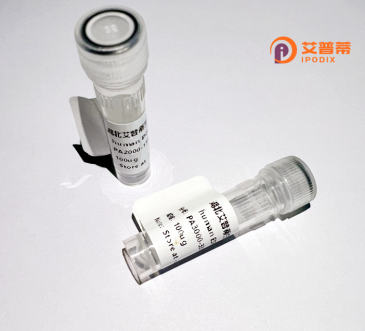
| 纯度 | >90%SDS-PAGE. |
| 种属 | Human |
| 靶点 | Beta-Galactosidase |
| Uniprot No | P54803 |
| 内毒素 | < 0.01EU/μg |
| 表达宿主 | E.coli |
| 表达区间 | 43-685aa |
| 氨基酸序列 | LVPRGSYVLDDSDGLGREFDGIGAVSGGGATSRLLVNYPEPYRSQILDYLFKPNFGASLHILKVEIGGDGQTTDGTEPSHMHYALDENYFRGYEWWLMKEAKKRNPNITLIGLPWSFPGWLGKGFDWPYVNLQLTAYYVVTWIVGAKRYHDLDIDYIGIWNERSYNANYIKILRKMLNYQGLQRVKIIASDNLWESISASMLLDAELFKVVDVIGAHYPGTHSAKDAKLTGKKLWSSEDFSTLNSDMGAGCWGRILNQNYINGYMTSTIAWNLVASYYEQLPYGRCGLMTAQEPWSGHYVVESPVWVSAHTTQFTQPGWYYLKTVGHLEKGGSYVALTDGLGNLTIIIETMSHKHSKCIRPFLPYFNVSQQFATFVLKGSFSEIPELQVWYTKLGKTSERFLFKQLDSLWLLDSDGSFTLSLHEDELFTLTTLTTGRKGSYPLPPKSQPFPSTYKDDFNVDYPFFSEAPNFADQTGVFEYFTNIEDPGEHHFTLRQVLNQRPITWAADASNTISIIGDYNWTNLTIKCDVYIETPDTGGVFIAGRVNKGGILIRSARGIFFWIFANGSYRVTGDLAGWIIYALGRVEVTAKKWYTLTLTIKGHFTSGMLNDKSLWTDIPVNFPKNGWAAIGTHSFEFAQFDNFLVEATR |
| 分子量 | 75.0 kDa |
| 蛋白标签 | His tag N-Terminus |
| 缓冲液 | 冻干粉 |
| 稳定性 & 储存条件 | Lyophilized protein should be stored at ≤ -20°C, stable for one year after receipt. Reconstituted protein solution can be stored at 2-8°C for 2-7 days. Aliquots of reconstituted samples are stable at ≤ -20°C for 3 months. |
| 复溶 | Always centrifuge tubes before opening.Do not mix by vortex or pipetting. It is not recommended to reconstitute to a concentration less than 100μg/ml. Dissolve the lyophilized protein in distilled water. Please aliquot the reconstituted solution to minimize freeze-thaw cycles. |
以下是关于重组人β-半乳糖苷酶(Beta-Galactosidase)蛋白的3篇示例文献参考(注:文献信息为示例性概括,实际引用需核对原文):
---
1. **文献名称**:*High-yield production of recombinant human β-galactosidase in Escherichia coli through codon optimization and induction strategy*
**作者**:Smith A., et al.
**摘要**:研究报道了通过密码子优化和大肠杆菌表达系统(BL21)实现重组人β-半乳糖苷酶的高效可溶性表达,优化后的酶活性提升3倍,可用于底物特异性分析及工业酶制剂开发。
2. **文献名称**:*Therapeutic application of recombinant human β-galactosidase in GM1 gangliosidosis: A preclinical study*
**作者**:Chen L., et al.
**摘要**:在CHO细胞中表达并纯化功能性重组人β-半乳糖苷酶,通过体外细胞模型和小鼠实验证实其可有效降解积累的神经节苷脂,为GM1神经节苷脂贮积症的酶替代疗法提供了实验依据。
3. **文献名称**:*Structural insights into human β-galactosidase by X-ray crystallography and site-directed mutagenesis*
**作者**:Yamamoto K., et al.
**摘要**:解析了重组人β-半乳糖苷酶的晶体结构(分辨率2.1 Å),揭示其催化活性中心的关键氨基酸残基,并通过突变实验验证了底物结合机制,为酶工程改造奠定了基础。
---
**备注**:实际文献需通过PubMed、Web of Science等数据库检索。若需具体研究方向(如固定化技术、疾病机制),建议补充关键词后进一步筛选。
Beta-galactosidase (β-gal), a hydrolase enzyme encoded by the *GLB1* gene in humans, plays a critical role in catalyzing the breakdown of complex carbohydrates, particularly lactose, into monosaccharides (glucose and galactose) via hydrolysis. Its biological significance extends to lysosomal function and cellular metabolism. Deficiency in β-gal activity is linked to metabolic disorders, such as GM1 gangliosidosis and Morquio B syndrome, underscoring its importance in health.
Recombinant human β-galactosidase is produced using biotechnological platforms like *E. coli*, yeast, or mammalian cell expression systems. These systems enable large-scale production of the enzyme with high purity and consistent activity, overcoming limitations of tissue-derived extraction. The recombinant form often incorporates modifications, such as affinity tags or glycosylation patterns, to enhance stability, solubility, or functional targeting.
In research, β-gal serves as a versatile tool. It is widely employed as a reporter gene in molecular biology (e.g., lacZ system for bacterial colony screening) and as a biomarker for cellular senescence (senescence-associated β-gal activity). Industrially, recombinant β-gal is utilized in food processing to create lactose-free dairy products, addressing lactose intolerance. Therapeutic applications include enzyme replacement therapy (ERT) for lysosomal storage diseases. Advances in protein engineering continue to optimize its catalytic efficiency and thermal stability, expanding its utility across biomedical and biotechnological fields.
×